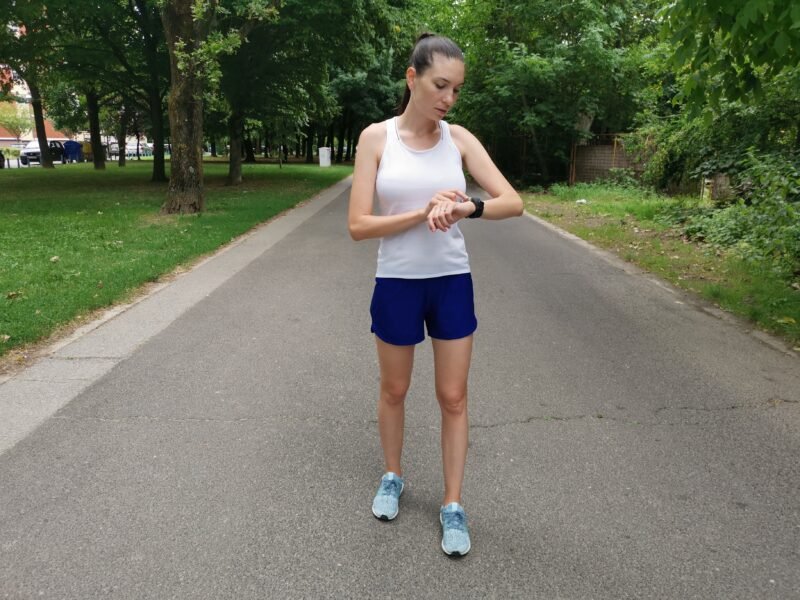How Many Miles is 7000 Steps? (Detailed Answer)
More and more people are turning to a healthy lifestyle and want to be as active as possible. Tracking the number of steps they take each day can be a helpful way to do this.
In this article, you will find out how many miles is 7000 steps. You will also get answers to the most frequently asked questions.
Generally, 7000 steps is approximately 3.29 miles. The exact distance you cover depends on several different factors, such as gender, height, stride length, and pace of walking or running.
An average stride length for adults is considered to be about 2.5 feet or 0.76 meters. Since there, we can calculate the number of miles covered by multiplying the number of steps by the stride length and converting the result to miles.
7000 steps * 2.5 feet = = 17500 feet / 5280 = 3.29 miles
Keep in mind that these calculations are estimates, and the actual distance covered may vary from person to person.
You can use a calculator to determine exactly how many miles is 7000 steps of walking or running.

How long does it take to walk 7000 steps?
Assuming an average stride length and a moderate walking pace, it can be estimated that it takes approximately 70 minutes to complete 7000 steps.
However, this is just a rough estimate, and individual results may vary.
Tip
If you want a more accurate estimation of the time it takes you to walk 7000 steps, you can measure your own stride length by walking a known distance (e.g., 100 feet) and counting the number of steps it takes. Then, divide the known distance by the number of steps to calculate your stride length. With that information, you can calculate the time it takes to walk 7000 steps by multiplying your stride length by 7000 and dividing by your walking speed.
Keep in mind that the primary focus should be on staying active and incorporating regular physical activity into your routine rather than fixating solely on the number of steps or time it takes to achieve them.
How long does it take to run 7000 steps?
On average, it takes approximately 30 minutes to run 7000 steps, which means that the average running pace is 9:07 minutes per mile.
Numerous factors, such as age, sex, fitness level, experience, weather, and terrain will all affect the result.
Beginners need approximately 35 minutes to run 7000 steps, which means that the average running pace is 10:38 minutes per mile.
Advanced runners need approximately 21 minutes to run 7000 steps, which means that the average running pace is 6:23 minutes per mile.
Am I active if I walk 7000 steps a day?
Walking 7000 steps a day is considered a lightly active lifestyle.
The World Health Organization (WHO) recommends that adults engage in at least 150 minutes of moderate-intensity aerobic physical activity throughout the week.
Regular walking has numerous health benefits, such as improved cardiovascular fitness, increased calorie expenditure, enhanced mood, and reduced risk of chronic diseases.
It is a low-impact exercise that is generally accessible and can be incorporated into daily routines.
When determining the daily step goal, keep in mind that your number of steps will be lower if you run or walk at a faster pace, and you will get a better workout.
So regardless of the lower number of steps achieved, you will get a great workout that will benefit your health.
How many calories are burned in 7000 steps?
On average, a person burns about 0.04 to 0.06 calories per step. Therefore, for 7000 steps, the estimated calorie expenditure would be approximately 280 to 420 calories.
It’s important to note that this is an estimate and individual results may vary.
Factors like age, gender, fitness level, and body composition can influence calorie burn during physical activity. Additionally, if you walk at a faster pace or encounter more challenging terrain, you may burn more calories.
Remember that physical activity is just one component of overall health and weight management.
Combining regular exercise with a balanced diet and other healthy lifestyle habits is essential for optimal results.
Does walking 7000 steps reduce belly fat?
Walking 7000 steps alone may not specifically target belly fat reduction, as spot reduction is generally not possible through exercise alone.
However, walking can contribute to overall weight loss and body fat reduction, including in the abdominal area.
Engaging in regular physical activity, such as walking, can help create a calorie deficit, which is necessary for weight loss.
When you consistently burn more calories than you consume, your body starts to utilize stored fat for energy, which can lead to a reduction in overall body fat, including the belly area.
Walking is a form of aerobic exercise that increases your heart rate and stimulates your metabolism.
While it may not burn as many calories as more intense exercises like running or high-intensity interval training, walking can still contribute to a calorie deficit when combined with a healthy diet.
Additionally, walking can help improve overall body composition by increasing muscle mass and toning your muscles, including the abdominal muscles.
This can lead to a more defined appearance as you reduce body fat.
It’s important to remember that reducing belly fat or achieving weight loss is a holistic process that requires a combination of regular exercise, a balanced and nutritious diet, and overall healthy lifestyle habits.
How many steps per day is healthy?
You probably heard many times the recommendation that it is necessary to take 10,000 steps a day for health benefits.
Where did that figure come from?
The magic figure of 10,000 steps per day actually came from a marketing campaign, not from scientific research.
It is actually the name of a pedometer that was sold in Japan in 1965. The device was called “Manpo-kei“, which literally means “10,000-step counter”.
Although the name of the device had a strictly promotional function, it stuck around the world and started indicating the daily goal for the number of steps.
Newer research indicates that even 7000 steps a day bring significant health benefits.
Tip
The answer to how many steps you need to take per day requires a more individual approach and should be based on your goals. The best number of steps for you is the one that can fit into your daily schedule and regular habits.
According to research, you can compare your step count with activity level categories:
- Inactive (sedentary lifestyle): less than 5000 steps a day
- Light active lifestyle: 5000 to 7499 steps a day
- Moderately active lifestyle: 7500 to 9999 steps a day
- Active lifestyle: 10000 to 12499 steps a day
- Highly active lifestyle: more than 12500 steps a day
When determining the daily step goal, keep in mind that your number of steps will be lower if you run or walk at a faster pace, and you will get a better workout.
So regardless of the lower number of steps achieved, you will get a great workout that will benefit your health.

How to make walking more interesting?
Walking is a great activity to clear your mind, but it can get boring over time, especially if you walk the same route every time.
Here are some ways to make walking more interesting:
1. Change your route
Walk a different route and explore a new area. This will allow you to change the environment and make walking more interesting.
2. Listen to music or a podcast
Make a playlist of your favorite music or find a podcast that interests you.
3. Walk with a friend
Sometimes we need additional motivation to be active. In these cases, make arrangements with your walking buddy. Not only will your time pass faster, but you will also do a great workout.
4. Set yourself goals
Challenge yourself to walk or run a certain distance or beat your previous time. This will give you a sense of accomplishment and further motivate you to continue.
5. Observe the surroundings
You may notice something new or interesting that you have never seen before.
6. Use a pedometer or activity tracker
Track your steps and distance with a pedometer or activity tracker. That way, you’ll be able to track your progress, which will help you stay motivated.
7. Add strength exercises
While walking, add strength exercises, for example, do a few squats, lunges, or push-ups. This can help improve your fitness level and reduce the risk of injury.
Read more: Strength Training for Runners (Top 19 Workout Exercises)

Plan your walking routine
Creating a routine for walking or any other activity will make it easier for you to maintain healthy habits.
You’re less likely to skip a workout or simply not have time for it.
Follow these tips to help you plan your walking routine:
1. Set your goals
Before you start walking, it’s important to think about why you want to walk.
Do you want to improve your health, lose weight, reduce stress, or simply enjoy nature? By knowing your goals, you can adapt the routine to your needs.
Read more: How To Set Running Goals? (Ultimate Guide)
2. Choose a walking route
Choose a route that is safe and comfortable for you. You can choose a park, a forest, or a treadmill at the gym, etc.
Keep in mind distance, terrain, and any other factors that may affect your walking.
3. Warm-up
Begin walking with a few minutes of gentle stretching or warm-up exercises to prepare your muscles and joints for the activity ahead.
Read more: 7 Reasons Why You Need to Warm-Up Before Running
4. Start slow
Start at a light and comfortable pace and gradually increase your walking speed.
If you are just starting to walk, start with shorter distances and gradually increase the distance over time.
5. Include intervals
Intervals are short bursts of higher-intensity activity distributed with periods of lower-intensity activity.
You can incorporate intervals into your walking/running routine by picking up your pace for short periods (e.g. 30 seconds to 1 minute) before returning to your normal pace.
6. Cool down
After walking, take a few minutes to cool down and stretch your muscles. This will prevent injury and promote recovery.
7. Establish a schedule
To make walking a regular habit, make a schedule that suits you. Aim to walk at least 30 minutes a day, 5 days a week, but of course, adjust this to your goals and fitness level.
8. Track your progress
Tracking your progress can help keep you motivated and you’ll be able to adjust your routine as needed.
You can use an activity app, or a simple training log to track your distance, pace, and how you feel while walking.
You can buy my Digital Running Log here.

Matea Matošević
Hi, I’m Matea! I’m an Olympic Marathon Runner, founder, and writer behind OLYRUN.com. On this site, I provide help in the form of my knowledge and experience to all who love running and active living. Read more…

